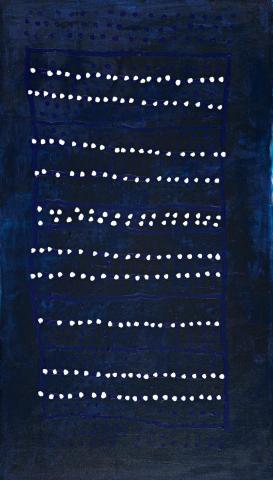BODY MARKS, 1999
PRINCE OF WALES (MITBUL)
synthetic polymer paint on linen
223.0 x 132.0 cm
inscribed verso: artist’s name, title, date, size and Karen Brown Gallery KB0242 and EP0001
Kululuk Community, Darwin (inscribed verso)
Karen Brown Gallery, Darwin
Private collection, Northern Territory
Private collection, Queensland
‘These paintings... I paint them on bodies...young people and old... ceremony for singing... dance... I make the marks’. Mitbul, Prince of Wales speaking about his art.1
In Larrakia culture the traditional land owners and leaders of ceremonies and dances are referred to as ‘King’. In around 1935 Prince of Wales was born Mitbul to Larrakia leader King George at Cullen, or Kahlin Beach, which at the time was the untouched bay of Darwin. Both parents passed away when Mitbul was very young and he was raised by his mother’s family to become a Law and Song Man. His ceremonial skills were legendary and he led many public corroborees for international visitors. As lead dancer for his people he led the ceremonial dance for Queen Elizabeth II on her Commonwealth visit to the Northern Territory during the 1970s, resulting in the name Prince of Wales. When he suffered an untimely stoke his ceremonial responsibilities were curtailed and he took up painting on canvas as a way to ensure that the ceremonial body decorations of his dance and song endured.
Body Marks, 1999, is one of the most ambitious canvases Prince of Wales ever executed. The white dots float almost ghost-like on the inky blue ground; it appears as a remembrance of a dance past and a powerful talisman of clan culture and tradition. The markings Prince of Wales would have originally painted onto the bodies of his clansmen prior to a ceremonial dance he has here transferred as a permanent record for posterity. The work was painted two years after his landmark solo exhibition of 1997 at Gallery Gabrielle Pizzi in Melbourne. In 2001 his standing as a Larrakia painter was recognised when he won the Telstra National Aboriginal and Torres Strait Islander Art Award for Painting.
1. Notes on Prince of Wales and the Gwalwa Daraniki Land Movement, kindly provided by Grant Smith, Gallery Gabrielle Pizzi
LARA NICHOLLS
